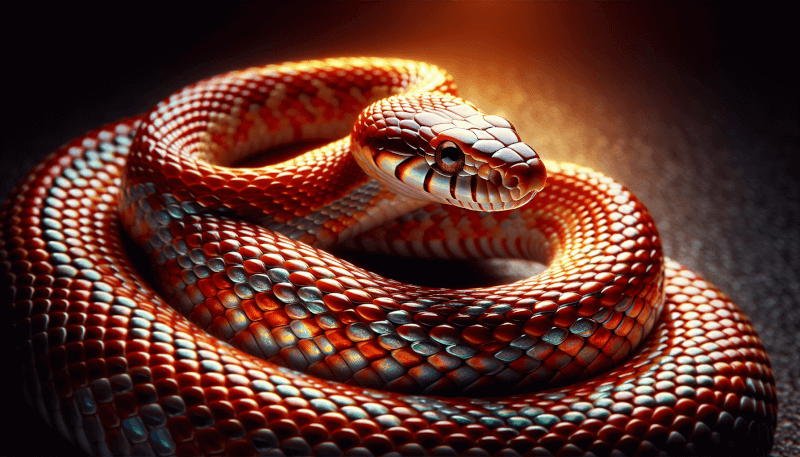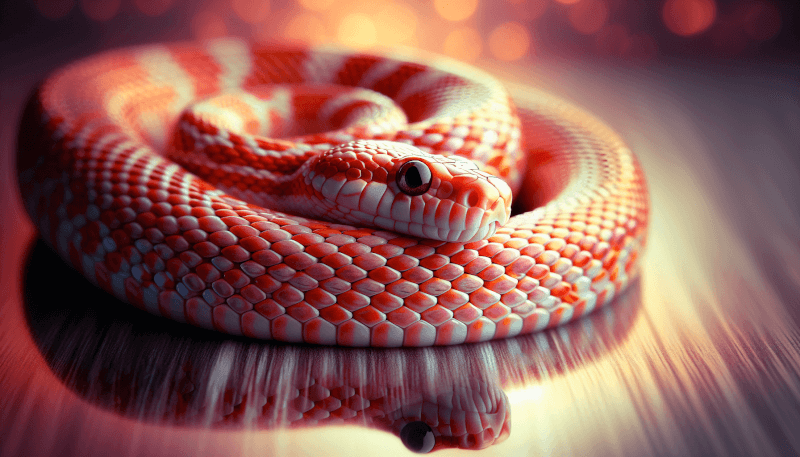Taking care of a corn snake is not as challenging as it may seem. These fascinating reptiles make great pets for both beginners and experienced snake owners. In this article, you will discover the essential tips and tricks to ensure the health and happiness of your corn snake. From creating the ideal habitat to feeding and handling, we will guide you step-by-step through the process of providing excellent care for your slithery friend. So, let’s dive into the world of corn snakes and learn how to be the best snake parent possible!
Housing
Choosing the right enclosure
When it comes to housing your corn snake, it is important to provide them with the right enclosure. A suitable enclosure should be spacious enough to allow your snake to move around comfortably. A tank or terrarium made of glass or plastic is a popular choice for corn snakes, as they provide good visibility and easy maintenance. It is recommended to have a minimum enclosure size of 20 gallons for juvenile corn snakes, and at least 40 gallons for adult corn snakes.
Setting up the enclosure
To set up the enclosure, you will need to create a comfortable and safe environment for your corn snake. Start by providing a substrate that allows for burrowing, such as aspen bedding or cypress mulch. This will help mimic their natural habitat. You will also need to include hiding spots, such as caves or logs, where your snake can retreat to when they feel the need for privacy or security. It is important to have a warm side and a cool side in the enclosure, so your corn snake can regulate their body temperature. Use heat lamps or heating pads to create a warm spot, and ensure there is a gradient of temperatures from one side of the enclosure to the other.
Maintaining proper temperature and humidity levels
Corn snakes are ectothermic, which means they rely on external heat sources to regulate their body temperature. It is crucial to maintain proper temperature levels in their enclosure to support their overall health and digestion. The warm side of the enclosure should be around 85-90°F (29-32°C), while the cool side should be around 75-80°F (24-27°C). Use a thermometer to monitor the temperature regularly and adjust the heating accordingly.
In addition to temperature, humidity is also an important factor in maintaining your corn snake’s health. The humidity level should be kept between 40-50%, as this is the range that best mimics their natural environment. Too high humidity can lead to respiratory problems, while too low humidity can cause shedding difficulties. Use a hygrometer to monitor the humidity level and make necessary adjustments. Regular misting or providing a humid hide can help maintain appropriate humidity levels.
Feeding
Choosing the right food
When it comes to feeding your corn snake, it is important to provide them with a diet that meets their nutritional needs. Corn snakes are carnivores, and their diet primarily consists of small rodents such as mice or rats. It is recommended to feed your corn snake pre-killed or frozen-thawed prey, as live prey can pose a risk of injury to both the snake and the prey animal.
Feeding schedule and portion size
The feeding schedule for corn snakes can vary depending on their age and size. Juvenile snakes should be fed every 5-7 days, while adult snakes can be fed every 10-14 days. It is important not to overfeed your snake, as obesity can lead to various health problems. The size of the prey should be around 1.5 times the diameter of the snake’s body. It is always better to offer smaller meals more frequently than larger meals infrequently.
Handling feeding difficulties
Some corn snakes may encounter difficulties when it comes to feeding. If your snake is refusing to eat, there are a few things you can try. First, ensure that the temperatures and humidity in the enclosure are within the appropriate range, as these factors can affect a snake’s appetite. If your snake is still not eating, try offering a different type of prey or using a different feeding method, such as scenting the prey with a bit of chicken broth. If the problem persists, it is recommended to consult a reptile veterinarian for further guidance.

Handling and Interaction
Proper handling techniques
When handling your corn snake, it is important to use proper technique to ensure the safety and comfort of both you and your snake. Start by supporting the snake’s body with both hands, making sure not to squeeze or put too much pressure on their delicate frame. Always handle your snake gently and avoid sudden movements or loud noises that may startle them. It is also important to wash your hands before and after handling your snake to prevent the spread of any bacteria.
Building trust and reducing stress
Snakes can be initially skittish or nervous when being handled. It is important to build trust with your corn snake gradually by starting with short handling sessions and slowly increasing the duration over time. Avoid handling your snake when they are in the middle of shedding or after feeding, as this can cause stress. Providing a secure and predictable environment for your snake will also help reduce stress and make them feel more comfortable during handling.
Ensuring safety during handling
Safety is paramount when handling any snake, including corn snakes. Always handle your snake over a safe and soft surface, such as a bed or a towel, to prevent injuries in case they accidentally fall. Keep a close eye on your snake’s behavior during handling and be aware of any signs of stress or aggression. If your snake becomes defensive or aggressive, it is best to put them back into their enclosure and try handling at a later time.
Health and Hygiene
Regular health check-ups
Regular health check-ups are essential for the overall well-being of your corn snake. It is recommended to find a reptile veterinarian experienced in treating snakes and schedule annual check-ups. During these visits, the vet will assess the snake’s physical condition, check for any signs of illness or parasites, and provide necessary vaccinations. These check-ups are also a great opportunity for you to ask any questions or discuss any concerns you may have about your snake’s health.
Maintaining a clean enclosure
A clean enclosure is crucial for maintaining the health of your corn snake. Regularly remove any feces or soiled bedding from the enclosure to prevent the build-up of bacteria. Clean and disinfect the enclosure periodically using reptile-safe cleaning solutions to eliminate any potential pathogens. It is important to thoroughly rinse and dry the enclosure before placing your snake back in to ensure their safety and comfort.
Dealing with common health issues
Like any living creature, corn snakes can sometimes experience health issues. Some common health problems in corn snakes include respiratory infections, mites, or digestive issues. If you observe any signs of illness such as lethargy, loss of appetite, abnormal shedding, or unusual behavior, it is important to seek veterinary care as soon as possible. Prompt diagnosis and treatment can greatly improve the chances of a positive outcome for your snake.

Shedding
Recognizing signs of shedding
Shedding is a natural process for snakes, including corn snakes, and occurs as they grow. It is important to recognize the signs of shedding to ensure that your snake goes through the process smoothly. Some common signs include dull or opaque eye color, milky appearance on the scales, loss of appetite, and increased agitation.
Creating a suitable environment for shedding
To help your corn snake shed successfully, you can make some adjustments to their environment. Increase the humidity in the enclosure by misting the enclosure more frequently or providing a humid hide. This will help soften the old skin and make it easier for your snake to shed. It is also important to provide a rough surface, such as a branch or piece of bark, for your snake to rub against and facilitate the shedding process.
Assisting in the shedding process
In most cases, corn snakes will shed their skin without any assistance. However, if you notice that your snake is having difficulty shedding, you can assist them. Fill a shallow container with lukewarm water and allow your snake to soak in it for around 15 minutes. This will help further soften the old skin and make it easier for them to remove. Gently aid in the shedding process by carefully removing any loose skin that is still attached, being careful not to pull or tug too forcefully.
Enrichment
Creating a stimulating environment
Enriching your corn snake’s environment is important for their mental stimulation and overall well-being. Provide different types of hiding spots and rearrange them periodically to keep things interesting. You can also add various textures, such as rocks or branches, for your snake to explore. Adding fake plants or foliage can create a more natural and visually appealing environment for your snake.
Providing hiding spots and climbing branches
Hiding spots are crucial for the mental and physical health of your corn snake, as they provide a sense of security and privacy. Include multiple hiding spots throughout the enclosure, such as caves or logs, and make sure they are appropriately sized for your snake to comfortably fit in. Additionally, corn snakes are excellent climbers, so providing branches or perches allows them to engage in natural behaviors and exercise their muscles.
Offering interactive toys or puzzles
Corn snakes may not have the same level of interaction as a dog or cat, but they can still benefit from mental stimulation. Consider providing interactive toys or puzzles that encourage your snake to explore and use their senses. For example, you can hide food inside a foraging toy, or create a maze with various objects. These activities can help keep your snake engaged and prevent boredom.
Socialization
Introducing a second corn snake
If you are considering introducing a second corn snake to your household, it is important to proceed with caution. It is recommended to quarantine the new snake for at least 30 days to ensure they are free from any diseases or parasites. When introducing the snakes, do so gradually and under close supervision. Watch for any signs of aggression or stress, and be prepared to separate them if necessary.
Supervised interactions with humans
While corn snakes do not necessarily require socialization with humans, many owners enjoy handling and interacting with their snakes. When interacting with your corn snake, always supervise the interaction closely to ensure the safety of both you and the snake. Keep the handling sessions short initially and gradually increase the duration as your snake becomes more comfortable. It is important to respect your snake’s boundaries and never force them into a situation they are uncomfortable with.
Avoiding stress during socialization
Socialization can be a positive experience for both you and your corn snake, but it is important to minimize stress during the process. Avoid handling your snake too frequently or for extended periods, as this can cause unnecessary stress. Additionally, provide a quiet and calm environment during handling sessions and avoid sudden movements or loud noises that may startle your snake. Always be gentle and patient, and let your snake take the lead in terms of their comfort level.
Breeding
Determining readiness for breeding
Breeding corn snakes is a complex process and should only be undertaken by experienced owners. It is important to determine if your snakes are ready for breeding before attempting to introduce them. Female corn snakes should be at least 2-3 years old and have reached a healthy weight. Male corn snakes can be ready for breeding as early as one year old, but it is recommended to wait until they are closer to two years old for optimal health and fertility.
Preparing for the breeding season
If you decide to breed your corn snakes, it is important to carefully prepare for the breeding season. Ensure that both the female and male snakes are in optimum health and have been provided with a suitable diet and living conditions. Create a separate breeding enclosure that provides adequate space for the snakes and includes appropriate hiding spots and a temperature gradient. Gradually decrease the temperature in the breeding enclosure to simulate a winter period, which can help trigger the breeding process.
Caring for eggs and newborn corn snakes
If successful breeding occurs, you will need to provide proper care for the eggs and newborn corn snakes. Female corn snakes will lay their eggs approximately 30-40 days after breeding, and the eggs should be carefully removed and placed in an incubator. Maintain the temperature and humidity levels within the incubator as per the specific requirements of corn snake eggs. Once the eggs hatch, the newborn corn snakes should be provided with a separate enclosure, appropriate substrate, and small food items for feeding. It is essential to research and understand the specific requirements for caring for newborn snakes to ensure their health and well-being.
Common Mistakes to Avoid
Inadequate enclosure size
One common mistake to avoid when caring for a corn snake is providing an inadequate enclosure size. Corn snakes require enough space to move around and exercise, so make sure to provide an enclosure that is appropriate for their size and age. Always research and follow the recommended guidelines for enclosure sizes to ensure the optimal health and well-being of your snake.
Incorrect feeding practices
Feeding practices are another area where mistakes can occur. It is important to feed your corn snake the right type and size of prey, as well as maintaining a suitable feeding schedule. Avoid overfeeding your snake, as this can lead to obesity and other health issues. Additionally, ensure that the prey is pre-killed or frozen-thawed to prevent any injuries to your snake during feeding.
Neglecting hygiene and health care
Proper hygiene and health care are essential for your corn snake’s well-being. Neglecting to clean and disinfect the enclosure regularly can lead to the build-up of bacteria and the spread of diseases. Regular health check-ups with a reptile veterinarian are crucial for monitoring your snake’s overall health and detecting any potential issues early on. Make sure to stay attentive to your snake’s behavior and appearance, and address any concerns promptly.
Conclusion
Taking care of a corn snake can be a rewarding and fulfilling experience. By providing the right enclosure, maintaining proper temperature and humidity levels, choosing the right food, handling and interacting with care, and staying vigilant about your snake’s health, you can ensure a happy and healthy life for your corn snake. Remember to always research and educate yourself about corn snake care, as every snake is unique and may have specific needs. The joys and rewards of owning a corn snake are immeasurable, and with proper care, you can create a thriving partnership with your slithery friend.


